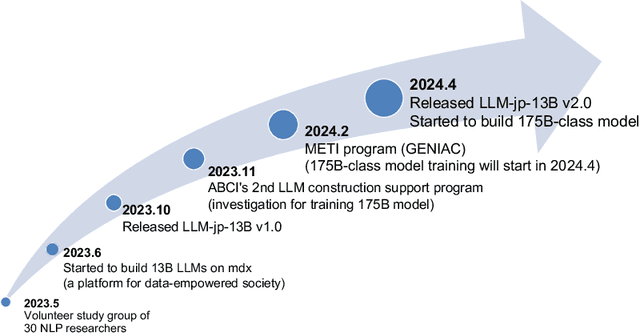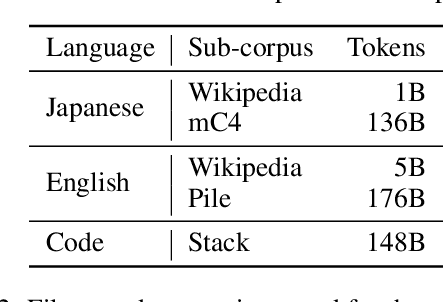Sakae Mizuki
Building Instruction-Tuning Datasets from Human-Written Instructions with Open-Weight Large Language Models
Mar 31, 2025Abstract:Instruction tuning is crucial for enabling Large Language Models (LLMs) to solve real-world tasks. Prior work has shown the effectiveness of instruction-tuning data synthesized solely from LLMs, raising a fundamental question: Do we still need human-originated signals for instruction tuning? This work answers the question affirmatively: we build state-of-the-art instruction-tuning datasets sourced from human-written instructions, by simply pairing them with LLM-generated responses. LLMs fine-tuned on our datasets consistently outperform those fine-tuned on existing ones. Our data construction approach can be easily adapted to other languages; we build datasets for Japanese and confirm that LLMs tuned with our data reach state-of-the-art performance. Analyses suggest that instruction-tuning in a new language allows LLMs to follow instructions, while the tuned models exhibit a notable lack of culture-specific knowledge in that language. The datasets and fine-tuned models will be publicly available. Our datasets, synthesized with open-weight LLMs, are openly distributed under permissive licenses, allowing for diverse use cases.
Why We Build Local Large Language Models: An Observational Analysis from 35 Japanese and Multilingual LLMs
Dec 19, 2024



Abstract:Why do we build local large language models (LLMs)? What should a local LLM learn from the target language? Which abilities can be transferred from other languages? Do language-specific scaling laws exist? To explore these research questions, we evaluated 35 Japanese, English, and multilingual LLMs on 19 evaluation benchmarks for Japanese and English, taking Japanese as a local language. Adopting an observational approach, we analyzed correlations of benchmark scores, and conducted principal component analysis (PCA) on the scores to derive \textit{ability factors} of local LLMs. We found that training on English text can improve the scores of academic subjects in Japanese (JMMLU). In addition, it is unnecessary to specifically train on Japanese text to enhance abilities for solving Japanese code generation, arithmetic reasoning, commonsense, and reading comprehension tasks. In contrast, training on Japanese text could improve question-answering tasks about Japanese knowledge and English-Japanese translation, which indicates that abilities for solving these two tasks can be regarded as \textit{Japanese abilities} for LLMs. Furthermore, we confirmed that the Japanese abilities scale with the computational budget for Japanese text.
LLM-jp: A Cross-organizational Project for the Research and Development of Fully Open Japanese LLMs
Jul 04, 2024



Abstract:This paper introduces LLM-jp, a cross-organizational project for the research and development of Japanese large language models (LLMs). LLM-jp aims to develop open-source and strong Japanese LLMs, and as of this writing, more than 1,500 participants from academia and industry are working together for this purpose. This paper presents the background of the establishment of LLM-jp, summaries of its activities, and technical reports on the LLMs developed by LLM-jp. For the latest activities, visit https://llm-jp.nii.ac.jp/en/.
Building a Large Japanese Web Corpus for Large Language Models
Apr 27, 2024


Abstract:Open Japanese large language models (LLMs) have been trained on the Japanese portions of corpora such as CC-100, mC4, and OSCAR. However, these corpora were not created for the quality of Japanese texts. This study builds a large Japanese web corpus by extracting and refining text from the Common Crawl archive (21 snapshots of approximately 63.4 billion pages crawled between 2020 and 2023). This corpus consists of approximately 312.1 billion characters (approximately 173 million pages), which is the largest of all available training corpora for Japanese LLMs, surpassing CC-100 (approximately 25.8 billion characters), mC4 (approximately 239.7 billion characters) and OSCAR 23.10 (approximately 74 billion characters). To confirm the quality of the corpus, we performed continual pre-training on Llama 2 7B, 13B, 70B, Mistral 7B v0.1, and Mixtral 8x7B Instruct as base LLMs and gained consistent (6.6-8.1 points) improvements on Japanese benchmark datasets. We also demonstrate that the improvement on Llama 2 13B brought from the presented corpus was the largest among those from other existing corpora.
Continual Pre-Training for Cross-Lingual LLM Adaptation: Enhancing Japanese Language Capabilities
Apr 27, 2024



Abstract:Cross-lingual continual pre-training of large language models (LLMs) initially trained on English corpus allows us to leverage the vast amount of English language resources and reduce the pre-training cost. In this study, we constructed Swallow, an LLM with enhanced Japanese capability, by extending the vocabulary of Llama 2 to include Japanese characters and conducting continual pre-training on a large Japanese web corpus. Experimental results confirmed that the performance on Japanese tasks drastically improved through continual pre-training, and the performance monotonically increased with the amount of training data up to 100B tokens. Consequently, Swallow achieved superior performance compared to other LLMs that were trained from scratch in English and Japanese. An analysis of the effects of continual pre-training revealed that it was particularly effective for Japanese question answering tasks. Furthermore, to elucidate effective methodologies for cross-lingual continual pre-training from English to Japanese, we investigated the impact of vocabulary expansion and the effectiveness of incorporating parallel corpora. The results showed that the efficiency gained through vocabulary expansion had no negative impact on performance, except for the summarization task, and that the combined use of parallel corpora enhanced translation ability.
Semantic Specialization for Knowledge-based Word Sense Disambiguation
Apr 22, 2023Abstract:A promising approach for knowledge-based Word Sense Disambiguation (WSD) is to select the sense whose contextualized embeddings computed for its definition sentence are closest to those computed for a target word in a given sentence. This approach relies on the similarity of the \textit{sense} and \textit{context} embeddings computed by a pre-trained language model. We propose a semantic specialization for WSD where contextualized embeddings are adapted to the WSD task using solely lexical knowledge. The key idea is, for a given sense, to bring semantically related senses and contexts closer and send different/unrelated senses farther away. We realize this idea as the joint optimization of the Attract-Repel objective for sense pairs and the self-training objective for context-sense pairs while controlling deviations from the original embeddings. The proposed method outperformed previous studies that adapt contextualized embeddings. It achieved state-of-the-art performance on knowledge-based WSD when combined with the reranking heuristic that uses the sense inventory. We found that the similarity characteristics of specialized embeddings conform to the key idea. We also found that the (dis)similarity of embeddings between the related/different/unrelated senses correlates well with the performance of WSD.
 Add to Chrome
Add to Chrome Add to Firefox
Add to Firefox Add to Edge
Add to Edge